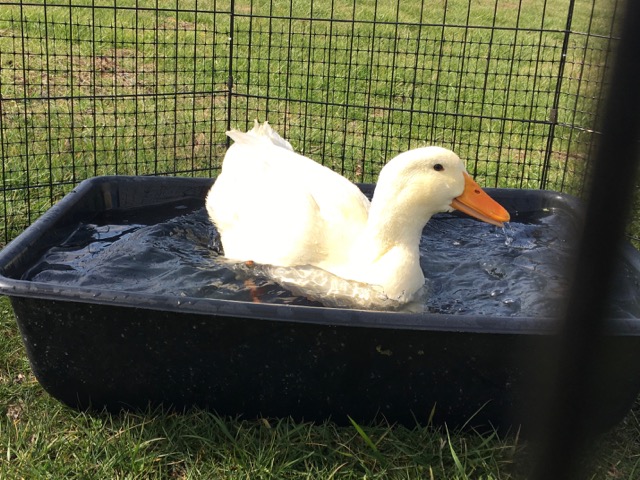
It’s gray, wet, muddy, and generally unpleasant out today, so I’m going to wax nostalgic and recall this weekend’s much nicer weather…
On Saturday, it was 73 degrees outside (in March) and sunny – a good day to fill up a tub and let the biggest water-lover of the bunch, Bob, take a leisurely solo bath. All of the ducks love a bath, but Bob would stay in the water all day, if he could. He’s the first to get into a pool, and the last to get out.
Bob is a Pekin, a large, white, friendly drake. He’s really easy to handle and doesn’t try to slap you around with his wings like our Muscovy drakes do. Pekins are a popular breed and ducklings are commonly sold at feed/farm supply stores – they’re the bright yellow ducklings. Unfortunately, chicks and ducklings of different breeds can get mixed together unintentionally when they’re at farm stores, especially the stores that place their poultry where kids can reach them. I’ve walked by the stock tanks full of chicks and ducklings at a certain feed store multiple times and seen, despite the small signs posted admonishing shoppers not to handle the chicks and ducklings, kids reaching into the containers to play with the animals. Sure, the store should have personnel posted to keep an eye on the area (there were no employees to be seen at any of the times I browsed the chick aisle), but in truth, the responsibility ultimately rests with the kids’ parents to supervise them properly. Otherwise, young animals can be dropped and injured, or simply be placed back in the wrong brooders.
Bob was acquired by his original owner with another duckling, thought to also be a Pekin…who actually turned out to be an Indian Runner. Duckling breeds can sometimes be difficult to tell apart when they’re very young; ensuring that they remain in their designated brooder by preventing accidental mixing of the sort I’ve described isn’t exactly rocket science. A different farm store has a practice that the aforementioned one could learn from: place the stock tanks behind a barrier (gate) that makes reaching the chicks and ducklings difficult, if not impossible. Even better, another farm store in the area keeps their chicks in a completely enclosed brooder and only store employees are allowed to reach into it. I imagine the potential for mix-ups is significantly reduced using these two methods.
But I digress..Bob thoroughly enjoyed his lengthy bath, and enthusiastically splashed me when I approached to take photos (and a short video). It’s one of the hazards of being a waterfowl “phonetographer” – water is going to get on you, and probably in your eyes and/or mouth. It’s a good thing I eat consume lots of probiotics to keep my immune system strong! Bob got chopped grass in his water, which he eagerly dabbled up: food in his water, what could be better to a duck?
